- Home
- Max Brooks
The Zombie Survival Guide: Complete Protection From the Living Dead Page 4
The Zombie Survival Guide: Complete Protection From the Living Dead Read online
Page 4
2.
Missing persons, particularly in wilderness or uninhabited areas. Pay careful attention if one or more of the search members end up missing. If the story is televised or photographed, watch to see what level of armament the search parties carry. Any more than one rifle per group could mean that this is more than just a simple rescue operation.
3.
Cases of “violent insanity” in which the subject attacked friends or family without the use of weapons. Find out if the attacker bit or tried to bite his victims. If so, are any of the victims still in the hospital? Try to discover if any of these victims mysteriously died within days of their bite.
4.
Riots or other civil disturbances that began without provocation or other logical cause. Common sense will dictate that violence on any group level does not simply occur without a catalyst such as racial tension, political actions, or legal decisions. Even so-called “mass hysteria” can always be traced to a root source. If none can be found, the answer may lie elsewhere.
5.
Disease-based deaths in which either the cause is undetermined or seems highly suspect. Deaths from infectious disease are rare in the industrialized world, compared to a century ago. For this reason, new outbreaks always make the news. Look for those cases in which the exact nature of the disease is unexplained. Also, be on the alert for suspicious explanations such as West Nile virus or “mad cow” disease. Either could be examples of a cover-up.
6.
Any of the above in which media coverage was forbidden. A total press blackout is rare in the United States. The occurrence of one should be regarded as an immediate red flag. Of course, there may be many reasons other than an attack of the living dead. Then again, any event causing a government as media-conscious as our own to clamp down merits close attention. The truth, no matter what it is, cannot be good.
Once an event has tripped your sensors, keep track of it. Note the location, and its distance from you. Watch for similar incidents around or near the original site. If, within a few days or weeks, these incidents do occur, study them carefully. Note the response of law enforcement and other government agencies. If they react more forcefully with each occurrence, chances are that an outbreak is unfolding.
WEAPONS AND COMBAT TECHNIQUES
At least fifteen or twenty of them; men, women, children. We opened up at seventy, maybe eighty meters. I could see chunks of flesh blasting off their bodies. Our rounds were hitting their mark! They kept coming, they just kept coming! I sighted one and let go a full burst from my BXP. I know I snapped his spine, because the man dropped like a leaf. Legs still twitching, he kept crawling after me! At twenty meters, we opened up with the Vektor. Nothing! I watched bits of organ and bone blown out their backs. I watched limbs literally sawed off at the joints. The SS77 is the best MG ever made, 840 meters per second, 800 rounds per minute, and it wasn’t doing a goddamn thing! What grenades we had only downed one of them. One! His mangled body lay motionless with a still-snapping head! [Name Withheld] let go with his RPG. The damn rocket went right through its soft target and took out a rock behind it! Finally, at five meters, we used the last bit of fuel in the flamethrower! The sons of bitches lit up like torches but just wouldn’t stop! One of them grabbed [Name Withheld], setting him on fire as it bit through his neck. I saw the rest of those things surround him as we took off for the jungle, a mob of burning bodies squatting down to tear another screaming human torch apart. Goddamn the devil’s mother, what the hell were we supposed to do!?!
—SERBIAN MERCENARY DURING THE ZAIRIAN CIVIL WAR, 1994
Choosing the right weapons (never carry just one) can make the difference between a pile of dead zombies and becoming one yourself. When confronted with the undead, it is easy to believe in the super-commando strategy: Load up with the heaviest, most powerful weapons possible and go out to “kick ass.” This is not only foolish—it is suicidal. Zombies are not camp guards in some POW escape movie, crumbling en masse with the first theatrical volley. Arming yourself for a zombie encounter requires careful consideration, a cool head, and a practical analysis of all factors involved.
GENERAL RULES:
1.
OBEY THE LAW!: Regulations governing weapons such as firearms and explosives depend on your location. Follow them to the letter. Punishment may range from a sizable fine to incarceration. In any case, the resulting criminal record is something you cannot afford! When the dead rise, law enforcement must look upon you as a model citizen, someone to be trusted and left alone, not a felon of questionable background who should be interrogated at the first sign of trouble. Fortunately, as this chapter will show, simpler, legal weapons will serve you much better than paramilitary death machines.
2.
TRAIN CONSTANTLY: No matter what weapon you choose, from a simple machete to a semiautomatic rifle, it must become an extension of your body. Practice as often as possible. If classes are available, by all means sign up. Learning from qualified instructors will save immense time and energy. If the device can be disassembled, do so, both in sunlight and total darkness until you know every pin, every spring, every curve and edge of that all-important machine. With practice will come both experience and confidence, two traits you must develop in order to successfully do battle with the living dead. History has proven that a well-trained individual, with nothing but a rock, has a better chance of survival than a novice with the latest technological marvel.
3.
CARE FOR YOUR TOOLS: Weapons, no matter how simple they may be, must be cared for as if they were living things. Anyone with firearm experience knows that inspection and cleaning are part of everyday use. This also applies to close-combat weapons. Blades need polish and rust protection. Grips need checking and maintenance. Never abuse your tools or expose them to unnecessary damage. If possible, have them tested regularly by experienced professionals. These experts may detect early-stage defects imperceptible to the amateur user.
4.
BEWARE DISPLAY ITEMS: Many companies offer a variety of replica weapons, such as swords, bows, etc., that are meant merely for decoration. Always research your chosen item thoroughly and ensure that it is intended for actual use in the real world. Do not rely solely on the company’s word. “Battle ready” may mean the item could withstand a few blows on a theatrical stage, or at some historical fair, but it will snap in half during a life-or-death confrontation. If resources permit, purchase a duplicate item and train with it to the breaking point. Only then should you trust in its abilities.
5.
DEVELOP THE FIRST WEAPON: The human body, if cared for and trained properly, is the greatest weapon on earth. Americans are notorious for their bad diet, lack of exercise, and relentless fetish for labor-saving technology. As recognizable as the term “couch potato” is, a more accurate term would be “cattle”: fat, lazy, listless, and ready to be eaten. Weapon No. 1, the biological tool that is our body, can and must be transformed from prey to predator. Obey a strict diet and physical-fitness regimen. Concentrate on cardiovascular instead of strength-building exercise. Monitor any chronic health conditions you may have, no matter how small. Even if your worst ailment is allergies, treat them regularly! When a situation does arise, you must know exactly what your body is capable of! Study and master at least one martial art. Make sure its emphasis is on escaping holds rather than delivering blows. Knowing how to slip from a zombie’s clutches is the single most important skill you can possess when you find yourself in close combat.
CLOSE COMBAT
Hand-to-hand combat should almost always be avoided. Given a zombie’s lack of speed, it is much easier to run (or walk quickly) than stand and fight. However, it may be necessary to destroy a zombie at close quarters. When this happens, split-second timing is critical. A wrong move, a moment’s hesitation, and you may feel cold hands gripping your arm, or sharp, broken teeth biting into your flesh. For this reason above all, choosing a close-combat weapon is more important than any other in th
is section.
1. BLUDGEONS
When using a blunt weapon, the goal is to crush the brain (remember, the only way to kill a zombie is by destroying its brain). This is not as easy as it sounds. The human skull is one of the hardest, most durable surfaces in nature. So, of course, is the zombie’s. Extreme force is needed to fracture, let alone shatter it. However, this must be done, and done with a single, well-placed blow. Missing your target or failing to breach the bone will leave you with no second chance.
Sticks, ax handles, and other wooden clubs are good for knocking a zombie out of the way or beating off an individual attack. What they lack is the weight and strength necessary for a lethal strike. A section of lead pipe will work for a single encounter but is too heavy for those on the move. A sledgehammer has the same drawback and also requires practice for its user to hit a moving target. Aluminum bats are light enough to work for one, maybe two fights, but are known to bend after prolonged use. The standard, one-handed carpenter’s hammer has striking power but severely limited reach. Its short handle allows a zombie to grab your arm and pull it in. The police baton, made of acetate plastic (in most cases), is strong enough for any battle but lacks the lethal power for a one-blow kill. (Note: This was intended in its design.)
The best bludgeon is a steel crowbar. Its relatively lightweight and durable construction makes it ideal for prolonged close combat. Its curved, semi-sharpened edge also allows for a stabbing motion through the eye socket, directly into the brain case. More than one survivor has reported killing zombies in this manner. Another benefit of the crowbar is that it may be necessary to pry open a door, shift a heavy object, or perform other tasks for which it was originally designed. None of these functions can be accomplished with any of the previously mentioned items. Even lighter and more durable than the steel crowbar is the titanium model, now trickling into Western markets from Eastern Europe and the former Soviet Union.
2. EDGED WEAPONS
Blades, in any form, have advantages and disadvantages over bludgeons. Those that have enough strength to split the skull rarely stand up after many repetitions. For this reason, slicing, particularly decapitation, serves almost the same function as a head blow. (Note: The severed head of a zombie is still able to bite and must be regarded as a threat.) The advantage of slicing over bludgeoning is that it can make killing a zombie unnecessary. In some cases, simply chopping off a limb or severing the spine is enough to disable an undead assailant. (Note: Severing a limb also brings the possibility of contact with the virus through the exposed area.)
The civilian ax can easily crush a zombie’s skull, smashing through bone and brain in one swing. Decapitation is equally easy, which is why the ax has been the favored tool of executioners for centuries. Connecting with a moving head, however, might be difficult. Furthermore, if the swing ends in a total miss, you might be taken off balance.
The smaller, one-handed hatchet is a good weapon of last resort. If you find yourself cornered, and larger weapons are useless, a hatchet blow will more than take care of an attacker.
The sword is the ideal edged weapon, but not every kind will suffice. Foils, rapiers, and similar fencing weapons are not suited for slicing. Their only possible use would be a direct stab through the eye socket followed by a quick swirling action through the brain. This motion, however, has been accomplished only once, by a trained swordsman, and is therefore not recommended.
Single-handed long swords allow you a free hand for other tasks such as opening a door or defending your body with a shield. Their only drawback is the lack of swinging power. One arm may not have the strength to slice through the thick cartilage between bones. Another drawback is its user’s notorious lack of accuracy. Scoring a flesh wound anywhere on the body of a living opponent is one thing. Making an exact, clean chop through the neck is something else altogether.
Double-handed swords could be considered the best in their class, providing the strength and accuracy for perfect decapitation. Of this type, the Japanese Samurai Katana ranks first. Its weight (three to five pounds) is perfect for long-term conflicts, and its blade can sever the toughest organic fiber.
In tight quarters, shorter blades hold the advantage. The Roman Gladius is one choice, although combat-ready replicas are hard to find. The Japanese Ninjite boasts a two-handed grip and, in genuine models, renowned tempered steel. Both factors make it a superior weapon. The common machete, because of its size, weight, and availability, is probably your best choice. If possible, find the military type usually sold at Army surplus stores. Its steel tends to be of a higher quality, and its blackened blade helps concealment at night.
3. MISCELLANEOUS HAND WEAPONS
Spears, pikes, and tridents serve to skewer a zombie, keeping it out of reach but not necessarily scoring a kill. The chance of an eye-socket stab is possible, but remote. The medieval European halberd (an ax-spear hybrid) may serve as a chopping weapon but, again, requires great amounts of skill and practice to accomplish a decapitating blow. Other than using them as bludgeons, or keeping your attacker at a distance, these weapons serve little purpose.
Morning stars or “flails,” a spiked ball chained to a rod, do basically the same damage as a crowbar, albeit in a more dramatic way. The owner swings the rod in a wide, circular motion, providing enough momentum to bring the ball crashing through the skull of his or her opponent. Using this weapon takes considerable skill, and it is therefore not recommended.
The medieval European mace serves the same function as the standard household hammer but without benefit of the latter’s practical uses. A mace cannot pry open a door or window, drive a chisel, or hammer a nail. Attempting such an act could result in accidental injury. Therefore, carry this medieval weapon only when no alternative is available.
Knives are always useful, serving a variety of functions in a range of situations. Unlike a hatchet, they can kill a zombie only when the blade is stabbed through the temple, eye socket, or base of the skull. On the flip side, knives almost always weigh less than hatchets and, therefore, are better if you are on the move. When choosing a knife, make sure the blade is no more than six inches long and always smooth. Avoid serrated knives and saw-blade combinations found in survival knives, as they tend to become lodged in their victims. Imagine yourself stabbing one zombie through the temple and turning to engage the other three ghouls but not being able to retrieve your blade.
The trench spike is, without a doubt, the best compact anti-zombie weapon on earth. It is a combination of a seven-inch steel spike for a blade and brass knuckles for a handle. It was developed during the vicious hand-to-hand combat of World War I, where soldiers killed each other in trenches no wider than a few feet. Specifically, it was designed to stab downward, through an enemy’s steel helmet. You can imagine how effective this weapon would be against a zombie. The user could stab easily through a zombie’s skull, withdraw cleanly and quickly, then turn to either brain another zombie or, at the very least, knock one over with a brass-knuckle punch to the face. Original models are extremely rare, with barely a few remaining in museums and the homes of private collectors. However, if accurate, detailed schematics can be found, have one or perhaps two combat-ready, stress-tested replicas made. They will be an investment you will never regret.
The Shaolin Spade
This weapon bears special mention in the anti-ghoul arsenal. It may appear unconventional: a six-foot hardwood staff with a flat, bell-shaped blade on one end and an outward-facing crescent blade on the other. Its roots date back to a bronze-bladed agricultural tool used during the Chinese Shang Dynasty (1766–1122 B.C.E.). When Buddhism migrated to China, the spade was adopted by Shaolin monks as both tool and weapon. On several occasions, it has proven to be surprisingly effective against the living dead. Thrusting forward with either blade will produce instant decapitation, while its length provides complete safety for the user. This length does make it impractical for indoor combat, and it should therefore be avoided in those situations. In open space
s, however, nothing combines the safety of a spear with the killing power of a katana sword like the Shaolin spade.
A variety of other hand weapons exist around the world, and space does not permit the author to discuss each one individually. If you discover an implement or tool that you think might make a good weapon, ask yourself these questions:
1.
Can it crush a skull in one blow?
2.
If not, can it decapitate in said blow?
3.
Is it easy to handle?
4.
Is it light?
5.
Is it durable?
Questions 3, 4, and 5 will have to depend on your present situation. Questions 1 and 2 are essential!
4. POWER TOOLS
Popular fiction has shown us the awesome, brutal power of the chainsaw. Its lightning-quick, rotating teeth can easily slice through flesh and bone, making the strength and skill required for manual weapons unnecessary. Its roar might also give the owner a much-needed psychological boost—empowerment in a situation where abject terror is a given. How many horror movies have you seen in which this industrial killing machine has spelled doom for anyone and anything it touched? In reality, however, chainsaws and similar powered devices rank extremely low on the list of practical zombie-killing weapons. For starters, their fuel supply is finite. Once drained, they provide as much protection as a hand-held stereo. Carrying extra fuel or power cells leads to the second inherent problem: weight. The average chainsaw weighs ten pounds, compared to a two-pound machete. Why increase the chances of exhaustion? Safety must also be considered. One slip, and the spinning teeth might be slicing through your skull just as easily as your enemy’s. Like any machine, another problem is noise. A chainsaw’s distinctive roar, even if running for just a few seconds, will be enough to broadcast to every zombie within earshot, “Dinner is served!”

 World War Z: An Oral History of the Zombie War
World War Z: An Oral History of the Zombie War Minecraft: The Island
Minecraft: The Island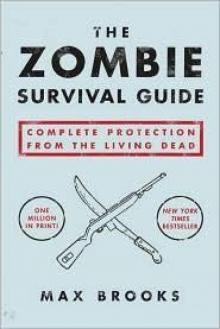 The Zombie Survival Guide: Complete Protection From the Living Dead
The Zombie Survival Guide: Complete Protection From the Living Dead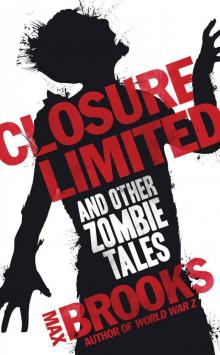 Closure, Limited and Other Zombie Stories
Closure, Limited and Other Zombie Stories Devolution: A Firsthand Account of the Rainier Sasquatch Massacre
Devolution: A Firsthand Account of the Rainier Sasquatch Massacre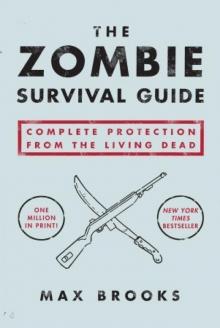 The Zombie Survival Guide
The Zombie Survival Guide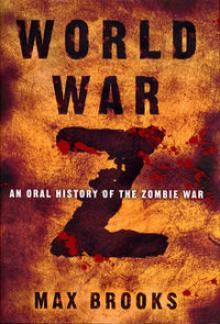 World War Z
World War Z Closure, Limited
Closure, Limited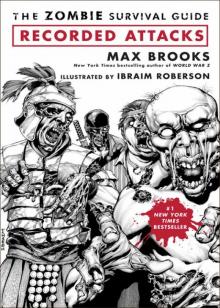 The Zombie Survival Guide: Recorded Attacks
The Zombie Survival Guide: Recorded Attacks World War Z_An Oral History of the Zombie War
World War Z_An Oral History of the Zombie War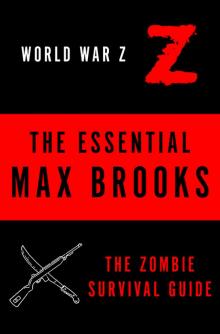 The Essential Max Brooks: The Zombie Survival Guide and World War Z
The Essential Max Brooks: The Zombie Survival Guide and World War Z